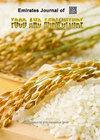Optimizing the making of modified plantain flour by the mixed-culture of lactic acid bacteria and yeast
IF 0.7
4区 农林科学
Q3 AGRONOMY
引用次数: 0
Abstract
Fermentation factors in the making of modified plantain flour must be optimized to obtain optimum conditions that produce the desired characteristics of flour/starch. In this research, we used mix-cultured lactic acid bacteria (LAB) and yeast for plantain fermentation. Response Surface Methodology (RSM) was used to explain the quantitative relationship between input and response variables. The design used is Combine D-optimal. The quantitative independent variables (X) selected were A = culture concentration (lower limit 2%; upper limit 6%) and B = fermentation time (lower limit 8 hours; upper limit 24 hours). Descriptive variables were C = type of plantain (C1 = “tanduk” plantain; C2 = “nangka” plantain) and D = type of culture (D1 = SC; D2 = LAB1 + LAB2; D3 = LAB1 + LAB3; D4 = LAB2 + LAB3; D5 = LAB1 + LAB1 + SC; D6 = LAB1 + LAB3 + SC; D7 = LAB2 + LAB3 + SC). Parameters of flour characteristic analyzed or response (Y) were carboxyl number (Y1), total acid (Y2), swelling number (Y3), pH (Y4), paste clarity (Y5), gelatinization properties: peak (Y6); trough 1 (Y7); breakdown (Y8); final viscosity (Y9); setback(Y10); peak time (Y11); pasting temperature (Y12), water content (Y13), color : *L (Y14); *a(Y15); *b (Y16) and c (Y17). The result showed that a combination of 6% culture concentration and 12.62 hours of fermentation time with a desirability value of 0.66 was the optimum condition with carboxyl value 0.15, total acid 0.47, swelling rate 13.49, peak time 5397.02, breakdown 2259.22, final viscosity 4125.22, setback 98.99, and dL 65.59. Keywords: modification flour, optimum condition, fermentation通过乳酸菌和酵母的混合培养优化改性车前草粉的制作过程
在制作改良车前草面粉的过程中,必须对发酵因素进行优化,以获得最佳条件,产生所需的面粉/淀粉特性。在这项研究中,我们使用混合培养的乳酸菌(LAB)和酵母进行车前草发酵。采用响应面法(RSM)来解释输入变量和响应变量之间的定量关系。采用的设计是组合 D-最优设计。选定的定量自变量(X)为 A = 培养浓度(下限 2%;上限 6%)和 B = 发酵时间(下限 8 小时;上限 24 小时)。描述性变量为 C = 车前草类型(C1 = "tanduk" 车前草;C2 = "nangka" 车前草)和 D = 培养物类型(D1 = SC;D2 = LAB1 + LAB2;D3 = LAB1 + LAB3;D4 = LAB2 + LAB3;D5 = LAB1 + LAB1 + SC;D6 = LAB1 + LAB3 + SC;D7 = LAB2 + LAB3 + SC)。分析或响应(Y)的面粉特性参数有:羧基数(Y1)、总酸(Y2)、膨胀数(Y3)、pH 值(Y4)、糊状物透明度(Y5)、糊化特性:峰值 (Y6);低谷 1 (Y7);分解 (Y8);最终粘度 (Y9);后退 (Y10);峰值时间 (Y11);糊化温度 (Y12);含水量 (Y13);颜色:*L (Y14);*a (Y15);*b (Y16) 和 c (Y17)。结果表明,培养浓度为 6%、发酵时间为 12.62 小时、可取值为 0.66 的组合是最佳条件,其羧基值为 0.15,总酸为 0.47,膨胀率为 13.49,峰值时间为 5397.02,分解时间为 2259.22,最终粘度为 4125.22,后退率为 98.99,dL 为 65.59。 关键词:改良面粉、最佳条件、发酵
本文章由计算机程序翻译,如有差异,请以英文原文为准。
求助全文
约1分钟内获得全文
求助全文
来源期刊

Emirates Journal of Food and Agriculture
AGRONOMYFOOD SCIENCE & TECHNOLOGY&nb-FOOD SCIENCE & TECHNOLOGY
CiteScore
1.80
自引率
0.00%
发文量
18
期刊介绍:
The "Emirates Journal of Food and Agriculture [EJFA]" is a unique, peer-reviewed Journal of Food and Agriculture publishing basic and applied research articles in the field of agricultural and food sciences by the College of Food and Agriculture, United Arab Emirates University, United Arab Emirates.
 求助内容:
求助内容: 应助结果提醒方式:
应助结果提醒方式:


